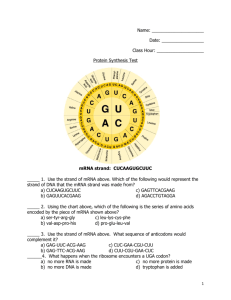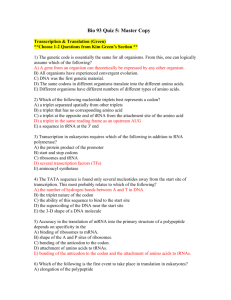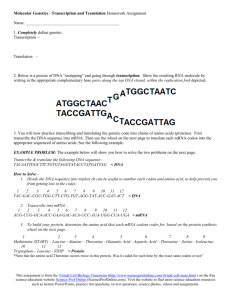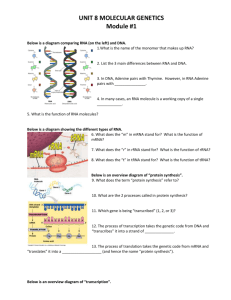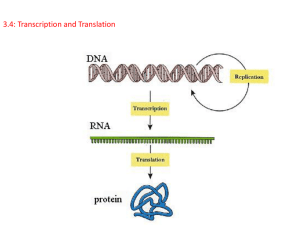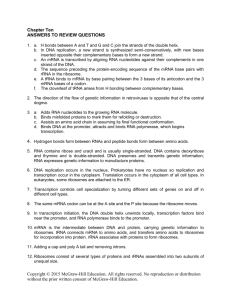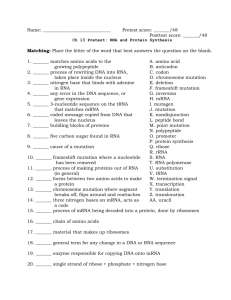The Central Dogma of Genetics
advertisement
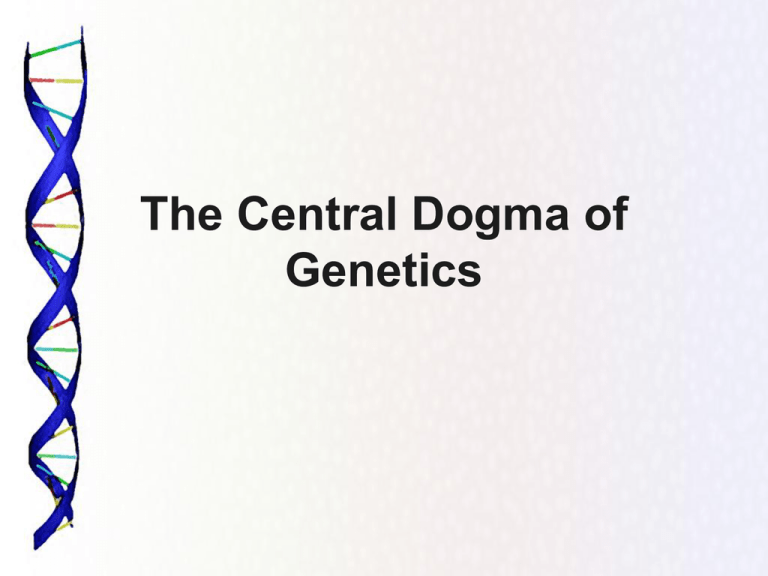
The Central Dogma of Genetics The Central Dogma • Proposed by Francis Crick in 1959 • DNA codes for RNA • RNA codes for protein • Protein determines our physical makeup – phenotype What are proteins? • Polymers of amino acids • Amino acid structure: Amino group Variable group ↑ Carboxyl group What are proteins? • There are 20 different amino acids. • The R group (called a “side chain”) is different for each amino acid. A few A.A. side chains: • Glycine: H • Alanine: CH3 • Serine: CH2OH • Tryptophan: A few A.A. side chains: • Only cysteine and methionine contain sulfur atoms in their side chains. These atoms can form “cross bridges” (aka disulfide bonds) • In General, side chains can be: –Polar -- Non-polar –Bulky -- Small –Positively charged –Negatively charged Amino Acids • Essential A.A.’s must be supplied by the diet, cannot be synthesized by organism. • Non-essential A.A.’s can be synthesized by organism. We like to bond • Links between amino acids are called peptide bonds. • Dehydration synthesis (joining by removal of H2O) • Carboxyl group of 1 A.A. links to amino group of another A.A. • Peptidyl transferase is the ribosomal enzyme responsible. Dehydration Synthesis Levels of structure • Primary Structure –The sequence of amino acids (ex: valine, proline, cysteine…) • Secondary Structure –Portions of the polypeptide form standard shapes: –Alpha helix –Beta pleated sheet Levels of structure • Tertiary structure –Unique folds and bends due to attraction of charges and polar A.A.s –Sulfur cross-bridges • Quaternary structure –Two or more polypeptides combine as functional protein Transcription • Information encoded in DNA is converted to mRNA by transcription. • RNA is different from DNA: –Ribose versus Deoxyribose –Uracil (U) versus Thymine (T) –Single-stranded versus doublestranded Transcription • Occurs on an Open Reading Frame (ORF). • An ORF is a sequence of DNA that gets transcribed: START codon many codons for A.A.’s Stop Codon Transcription • Both strands of DNA contain genes (ORFs) • Strand with the same base sequence as mRNA is the sense strand (coding strand). • Complimentary strand is the antisense strand (anticoding) • Antisense strand is the template for mRNA Transcription • 3 Stages: • Initiation • Elongation • Termination Transcription • Initiation –RNA Polymerase binds to promoter region of DNA • (TATA Box) –DNA is unzipped around RNA polymerase (transcription bubble) Transcription • Elongation –Complementary nucleotides are added to the mRNA chain using anticoding DNA as template. –New RNA nucleotides are added to 3’ end (like DNA) Transcription • Termination –RNA polymerase reaches “terminator sequence” at the end of gene. –mRNA floats away, is processed, then leaves nucleus through pores in nuclear envelope. mRNA Processing • Introns removed, exons spliced together. • Guanine “Cap” added to 5’ end. • Poly-A “Tail” added to 3’ end. RNA Processing Translation • Information in mRNA used to produce protein. • tRNA- “cloverleaf” molecule –Anticodon –Amino Acid loading • Ribosome – RNA and protein structure, “reads” mRNA tRNA: Translation • mRNA is read from 5’ to 3’ • 3 Bases make up a codon • Every codon codes for either an amino acid or STOP • Ribosome has 3 sites for tRNA binding: A site (Amino-acyl), P site (peptidyl), E site (exit). Process of Translation: • 1. A “loaded” tRNA pairs with its codon at the A site. • 2. A peptide bond forms between the amino acid and the previous a.a. chain as the tRNA moves to the P site. • 3. The tRNA shifts to the E site and “exits”, to be reloaded. Transcription/Translation are Linked in Bacteria


